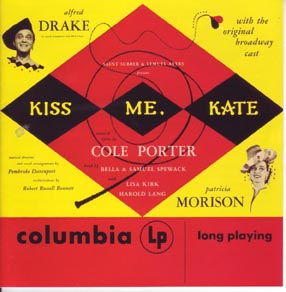
(845) 246-6944
· info@ArtTimesJournal.com
Shakespeare
on Broadway
By
FRANK BEHRENS
ART
TIMES December 2005
 |
I
have lost count of how many operas are based on the plays of
Shakespeare. I am also losing count of the Broadway shows that try to
translate the plays, mostly the comedies, into contemporary terms. One
of the most successful is the one I will start with.
Back
in the late 1940s, Cole Porter was in deep trouble. His last few wartime
musicals did not do very well while two others were outright disasters,
and he was having the devil’s own time raising money for this next show.
But the money came his way, and the show opened on December 30, 1948,
the first of 1,077 performances; and it went on to garnish awards for
best musical, best composer, best libretto (by Bella and Samuel Spewack),
best producers, best scenic and costume designs, and even best leading
man (Alfred Drake). The source: “The Taming of the Shrew.” The title:
“Kiss Me Kate.”
The
critics went wild. Of the 9 major papers, 8 gave it raves while the
other was merely very favorable. The Times called it a miracle
and compared the score surprisingly with Puccini! The Post called
it “a smash hit of epic proportions.” Everything worked right. Even
Patricia Morrison, whose voice was predicted not to go further than
the third row, was marvelous. And this was on Broadway, where Shakespeare
was considered box office poison. The Spewacks were very careful to
give the audience two plots, each mirroring the other: Petrucchio:Kate
= Fred:Lilly. Not all that original, but very well handled.
This
is one of those musicals in which the dialogue is as good as the lyrics.
However, audiences went to musicals to hear songs (not to look at computer-driven
stage effects as they do today); and great songs were what they got:
“Too Darn Hot,” “True to You in my Fashion,” “Were Thine That Special
Face,” “Wunderbar,” “Another Op’nin’Another Show,” all of which have
been heard so often out of context. What is really unusual is that even
the plot-oriented songs are just as good: “We Open in Venice,” “I Hate
Men,” and the very Gilbertian-trick-rhyme song “Brush Up Your Shakespeare.”
Actually,
Shakespeare did very well for himself earlier, in 1938, when Larry Hart
wanted to write a part for his brother Teddy who looked so much like
comedian Jimmy Savo that he could never get a role. Well, since they
looked so much alike, Larry went to “The Comedy of Errors,” which involves
two sets of twins, one of which is a pair of comic servants. Not surprisingly,
Savo was cast as one twin and Teddy fell neatly into place. The result
was “The Boys from Syracuse.”
It
only ran for 235 performances--remember, the Depression was still with
us--and is very seldom performed. Even the 1940 film with Alan Jones
seems to have disappeared; and I dearly wish some television station
would restore it and some local group revive the show. There are at
least three complete CD recordings of the score, and its absence from
the stage is a genuine loss for us all.
Consider
the two songs that became hits, “Falling in Love With Love” and “This
Can’t Be Love.” Among the less familiar numbers are “You Have Cast Your
Shadow on the Sea,” “Sing for Your Supper,” and “What Can You Do with
a Man?” Finally, there is a comic duet titled “He and She” that should
bring down the house.
Unlike
“Kiss Me Kate,” the plot more or less sticks to the Shakespeare original
but makes no attempt at period-sounding music. On the other hand, who
knows what music sounded like in ancient Ephesus?
 |
In
1981, something called “Oh, Brother!” used “Comedy of Errors” as the
basis for a musical, but it closed in two days. You see, the creators
decided to reset the story in the Persian Gulf in modern times. Ken
Mandelbaum in his fabulous history of Broadway flops, “Not Since Carrie”
(St. Martin’s Press, 1991), declares it deserved better. It suffered
mainly from a small cast with too many lead roles in a single set. He
suggests that with singers like Judy Kaye in the cast, they should have
revived “The Boys from Syracuse.” In fact, there was a revival in 1963
that ran longer than did the original.
Now
these are two very successful adaptations of Shakespeare’s plays. I’ll
bet anyone could name the blockbuster adaptation that outran even “Kiss
Me Kate,” but very few could discuss a 1938 musical based on “A Midsummer
Night’s Dream” and other flashes in the Broadway pan. Some of them will
be discussed in the next issue.